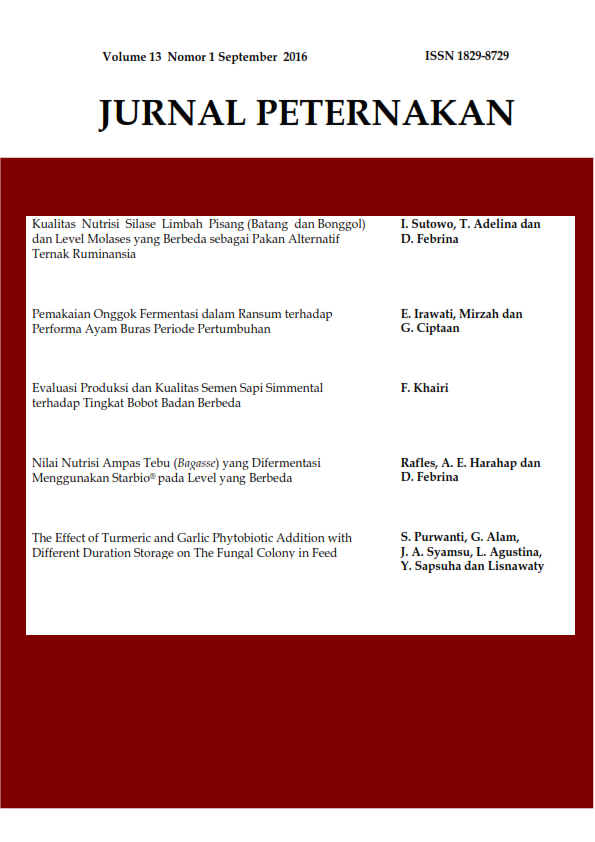THE EFFECT OF TURMERIC AND GARLIC PHYTOBIOTIC ADDITION WITH DIFFERENT DURATION STORAGE ON THE FUNGAL COLONY IN FEED
DOI:
https://doi.org/10.24014/jupet.v13i2.2421Keywords:
fungal colony, garlic, phytobiotic, storage, turmericAbstract
Turmeric and garlic phytobiotic contain bioactive substances, each of which has a function as an antifungal. The study aims to determined to test the ability turmeric and garlic phytobiotic pressed fungal colonies in the feed with different storage time. The data were analyzed by a factorial experimental design with 5 treatments 4 replications and 2 repetitions. The first factor types phytobiotic and the second factor was storage duration. R0 = basal ration (without phytobiotic), R1 = basal ration + 0.3% synthetic antifungal, R2 = basal ration + 2.5% turmeric, R3 = basal ration + 5% garlic, R4 = (basal ration + 2.5% turmeric+ 5% garlic. W0, W1, W2 and W3 respectively with storage time 0, 2, 4 and 6 weeks. Samples were taken from each experimental unit homogeneously. The results showed the average fungal colonies of garlic phytobiotic treatment (26.06±44.76 CFUx103/g) in 2-week storage time (25.20±22.52 CFUx103/g) lower than the provision of synthetic preservatives (57.75±52.03 CFUx103/g) and the control treatment (74.87±70.69 CFUx103/g). Fungal colonies increases rapidly with increasing length of time of storage. The conclusion of this study was that the additon of turmeric and garlic phytobiotic capable as an antifungal in feed.
Downloads
Published
Issue
Section
License
The Authors submitting a manuscript do so on the understanding that if accepted for publication, copyright of the article shall be assigned to Jurnal Peternakan and published by Fakultas Pertanian dan Peternakan Universitas Islam Negeri Sultan Syarif Kasim Riau as publisher of the journal.
Authors who publish with this journal agree to the following terms:
Authors automatically transfer the copyright to the journal and grant the journal right of first publication with the work simultaneously licensed under a Creative Commons (CC BY) that allows others to share the work with an acknowledgement of the work's authorship and initial publication in this journal.
Authors are able to enter into separate permission for non-exclusive distribution of the journal's published version of the work (e.g., post it to an institutional repository or publish it in a book), with an acknowledgement of its initial publication in this journal.
Authors are permitted and encouraged to post their work online (e.g., in institutional repositories or on their website) prior to and during the submission process, as it can lead to productive exchanges, as well as earlier and greater citation of published work (See The Effect of Open Access).

